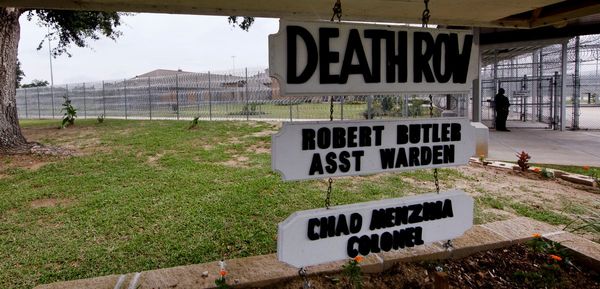
Support truly
independent journalism
A California woman is spending the rest of her life behind bars for the murders of two elderly women.
And, now at the age of 66, after being incarcerated for half of her life, she’s come full circle to focus on the rights of older women inmates.
Dana Gray was 36 years old in 1998 when a jury found her guilty in the slayings.
Her murderous spree came to an end when one woman who she strangled survived and IDed her.
Now, Gray is living out the rest of her days at Central California Women’s Facility (CCWF) – where she’s focused on fighting for the rights of female inmates. In particular, she says, woman who are “LWOPs” – those serving life sentences without the possibility of parole — are given a backseat to men when it comes to opportunity for rehabilitation and positive change.
“Most women are taught to just sit down, shut up, do what you’re told,” Gray told The Independent in a recent interview.
“That’s why we don’t fight back. That’s why we’re an easy population to manipulate. But it’s time that changed.”
Gray’s horrific past
There is a dark irony in Gray acknowledging that women are a vulnerable population.
In 1994, Gray was arrested and charged after three elderly women were found murdered within weeks of each other, in the Canyon Lake area, just south of Los Angeles. A fourth woman survived an attack and was able to identify Gray as the suspect.
On Valentine’s Day that year, Norma Davis, 86, was found dead in her home. She had been strangled and stabbed 11 times.
Just a couple of weeks later on February 28, there was another murder in Canyon Lake. June Roberts, 66, was found strangled and had been bludgeoned with a decanter.
In both slayings, police discovered the killer had swiped valuables and credit cards from the victims’ homes.
A flurry of activity showed up on Roberts’ credit card, her daughter told police. The suspect had gone on a shopping spree buying clothes, cowboy boots, perfume, vodka, a ski mask, and massages at a fancy spa.
The woman accused of using the cards was described to police as a petite, well-dressed blonde who drove a brown Cadillac and was accompanied by either a small boy or a tall, dark-haired man, police said.
Then, on March 16, Dora Beebe, 87, was killed in her Sun City condo. She had just returned home when a woman knocked on her door and asked for directions. Later that day, her boyfriend found her dead. She had been strangled and beaten to death with a steam iron.
Hours later, a young well-dressed woman withdrew $1,700 from her bank account.
Gray was arrested the following day.
‘This isn’t the Dana show’
For 30 years, Gray barely spoke publicly, especially to news outlets that might turn her story into a salacious headline and describe her as a serial killer – something she acknowledges she is, but believes she has been rehabilitated.
“I don’t want to talk about my crimes, because this isn’t the Dana show,” she said, noting that she doesn’t want anyone associated with the victims to be re-traumatized by having to hear about her awful crimes.
Instead, she said she wants to use her notoriety for something good.
“Victims do not have to be continually traumatized and looking over their shoulders. How can we make a way for victims to be heard and how can we help them heal? Is there a path for restorative justice with high notoriety cases? The victims, and their families, can be triggered by hearing it all over again,” she said.
“There’s no need for that. The victims should feel safe.”
She’s never spoken to the families of her victims, but said that if they wanted to, she would welcome them with open arms.
“If they want to come and cuss me out and tell me I’m a horrible person for what I did and for what they think I am, I invite them to because it’s cathartic for them,” she said. “I want them to know that I have changed. People change.”
Most of all, she wants them to know that she’s sorry.
“I want them to know I feel it,” Gray said, her voice as she choked back tears. “Thirty years later, I feel it. And I’m so sorry.”
The survivor
It was a fourth woman, who survived an attack just days earlier, that helped end Gray’s murderous spree.
On March 10, 1994, Dorinda Hawkins, 58, was working at an antiques shop in Lake Elsinore, Riverside County, when she was approached by a young woman with blonde hair who asked for help with some of the merchandise.
The woman, later identified as Gray, attempted to strangle Hawkins with a phone cord before snatching $5 from her purse and $20 from the cash register. She fled the scene and an hour later, she went on another shopping spree with Roberts’ card.
Hawkins survived and was able to give detectives a description of Gray.
She told them the last thing she remembered hearing before she blacked out was her attacker’s soothing voice as she told her: “Relax. Just relax.”
It was the kind of voice a doctor or nurse might use, she told them.
Years before her arrest, Gray worked as a labor and delivery nurse at Inland Valley Regional Medical Center. She had decided to become a nurse after watching the nurses take care of her mother who developed and later died of breast cancer when she was 14.
After Gray was arrested, she admitted to the thefts but denied killing the women.
“I got desperate to buy things,” she told detectives at the time. “Shopping puts me at rest.”
In 1998, she changed her plea to guilty, admitting to the Beebe and Roberts killings and the attempted murder of Hawkins.
The judge agreed to not charge Gray for the third murder as part of her plea deal. She was sentenced to life, without parole.
Life without parole in prison
While in prison, Gray, who is working on her degree in sociology and plans to get a master’s degree, now leads programs for fellow inmates.
Although she understands that she may never be released from her sentence, it hasn’t stopped her from trying – and imagining what she could do to help on the outside.
“It’s time for a rebranding,” Gray said. “We have more to offer the community and want to help. We can change division, change people’s thoughts about committing crime. We could stop it from happening. It’s possible, I truly believe it.”
“I think I would do a lot of good,” Gray added. “And it’s not like I wouldn’t reach back and help the ones still inside. I would.”
Some of her work is more controversial, with Gray fighting to ban trans women who have not had gender surgery from women’s prisons — although sexual assault rates for trans women kept in male prisons is nearly 60 per cent.
Regardless, Gray said that being in prison for such a long period of time means that she’s known by some as the mother they wished they had.
“They told me … they told me that I filled that gap of the relationship they would’ve liked to have with their mom,” Gray told The Independent in a recent interview, her voice cracking as she added: “Sorry this is making me emotional.”
“What does that say?” she continued. “It’s been 30 years – people can change. There is a human part of me, I just want people to see it.”







